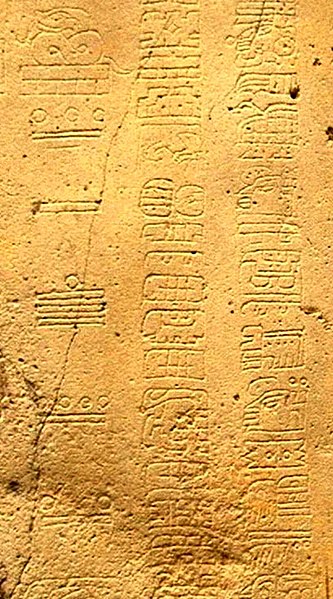The Maya were the first civilization to keep written historical records in the New World. They wrote using hieroglyphs with ideographic and phonetic elements. The Maya had several calendars. The “Long Count”, is a precise continuous record that uses solar and lunar years, as well as solstices and equinoxes. They used zero and a vigesimal positioning system. The writing system was preserved on stelae, as well as their calendar and astronomical knowledge.
The Maya system is based on twenty units. The numbering system uses three symbols: a shell for zero, a dot for one unit, and a line for five units. Since they used a vigesimal positioning system, numbers grow multiplied by twenties. The numbers are written vertically or horizontally.
The Maya Stela is read top to bottom. Glyphs and numbers denominate the day and month of the calendar as well as the period: Baktun, Katun, Tun, Uinal, and Kin. The Long Count calendar is built of three coordinated sub-calendars. The first is an astronomical calendar, 365.2420 days long, and was used to predict the solstices. The civil calendar Haab, 365 days long, is eighteen twenty day long months and a five day long month, Uayeb. The third calendar is the Tzolkin, 260 days long. This calendar was used by priests to set days for agricultural labor and religious ceremonies. The Tzolkin was also used as a secondary calendar system called the Sacred Round that combined the 13 day numbers cycle and the 20 day names cycle. The Maya designated an overlapping day in the Haab and Tzolkin calendars that created a joint cycle called the Calendar Round. The basic unit of the Maya year is the Kin, or day. The twenty day cycle of thirteen day numbers is the Uinal. The Maya year is split into nineteen parts, or months, each with a name and a glyph. Numbers are designated glyphs that correspond to the time period.
 |
Detail showing three columns of glyphs from 2nd century CE La Mojarra Stela 1.
The left column gives a Long Count date of 8.5.16.9.7, or 156 CE.
The two right columns are glyphs from the Epi-Olmec script. |

About the Author
I'm Melanie, the founder of BermudaQuest and an archaeology undergraduate at the University of New Mexico. I love writing about ancient and modern cultures. My goal is to make information about our origins available to everyone [in simple English!]







